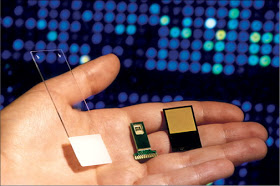Bio chip structure, function (PhD in nano-microelectronics)
Researcher and author: Dr. ( Afshin Rashid)
Note: bio chip A biosensor or bioprocessor that uses biomodern and micro- scale electronic technologies. Biochips basically perform small laboratories that perform hundreds or many of the biochemical responses simultaneously. Biochips enable scientists to perform large amounts of live analysis on a set of targets.
Biochip issmall version of a lab that uses hundreds of biochemical reactions simultaneously. They are specifically designed to function in a biological environment, especially within living organisms. This is not an electronic device. Biochips are made up of millions of biosensors that are used as micro-reactors to detect specific analytes such as enzymes, proteins, biological molecules and antibodies. Biochips have different probes such as DNA, RNAi, protein fragments, etc. that are indicated by a dot on the chip. These probes are connected to the targets in the test sample. Due to hybridization, contact is made between the probes and their target. Biochip scanners and microarray image analysis software are then used to identify the target and quantify the signal. The results are obtained at the statistical level and are interpreted in a biological context.
Bio Chip Biochips and biological chips in gene and protein arrays Although it has been several years since the identification of the structure and determination of the complete sequence of the human genome and it has been determined that the human genome is composed of 3 billion new clotides and about 30,000 genes, Major changes have not been made in solving hereditary diseases and discovering the causes of various human diseases due to the complexities in the human genetic structure and various factors affecting it. Because previously it was thought that a gene is responsible for an activity, and experts studied the structure and function of individual genes and proteins separately, but now it has been determined that several genes are involved in some disorders and a number of processes in A disease or cell damage and Tissues are involved. The result is that a method must be devised to simultaneously study the sequence, diversity, genetic differences, structure and activity of tens, hundreds and thousands of genoproteins .
Researcher and author: Dr. ( Afshin Rashid)
PhD in Nano-Microelectronics



